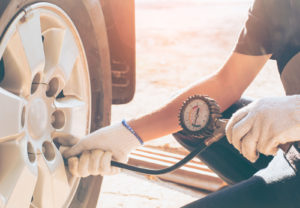What Should Your Tire Pressure Be?
July 8th, 2020 by Fix Auto USA

Ensuring that your tire pressure is correct is one of your most important responsibilities as a driver. Underinflated tires can put you and your passengers at risk. Tire failure or blow out becomes a real possibility.
According to the National Highway Traffic Safety Administration, more than 11,000 tire-related crashes occur in the U.S. every year. And the culprit in most of these accidents was under-inflated tires.
Not maintaining correct tire pressure also affects the size of your wallet because underinflated tires cause cars to run inefficiently and that means more frequent trips to the gas station.
How much air should be in a car tire?
So we can all agree that it is essential to keep your tires inflated.
But what is the correct tire pressure – that is the question!
The recommended car tire air pressure is typically between 30 and 35 PSI air pressure, or pounds per square inch, assuming your tires are cold.
You can usually find the manufacturer’s recommended tire pressure on a sticker inside the driver’s door or inside the owner’s manual.
If under inflating tires carries risks, so does overinflating them. For starters, tires that are inflated too much don’t last as long and are less safe because of reduced traction. Over inflating tires makes them rigid, accelerates wear, and also makes the ride feel stiff.
Your Tire Pressure Monitoring System is a great tool that shows flashing light indicating one of your tires is underinflated. However, don’t over-rely on your TPMS. It’s best to manually monitor your car tire air pressure yourself and think of TPMS as your backup support.
When’s the best time to check your car tire air pressure?
The best approach is to have a routine where you remember to check your car tire air pressure every time you fill up gas. Tires typically lose one pound of pressure per month. At the very least you should check it every 30 days.
How to maintain tire pressure
Once you know the correct tire pressure, you’ll want to invest in a tire pressure gauge to monitor your car tire air pressure easily. There is a variety of gauges on the market. It’s best to check the pressure when the tires are cold; let your car sit in one location for at least a couple hours.
If it indicates that you’re at or over 35 PSI, let out some air. If the pressure reading is lower than the PSI air pressure in your owner’s manual, you may want to add some air.
While we’re at it, here’s a reminder not to neglect your spare tire. Check its air pressure from time to time, because the last thing you want when you’re in a bind is an under-inflated spare tire. Also, spare tires tend to have higher pressure recommendations than regular tires, so again, check your owner’s manual.
Monitoring your car tire air pressure on an ongoing basis can extend the life of your tires and significantly reduce the chance of getting a flat tire. Monitor your tires for wear and be proactive about rotating them and maintaining their correct tire pressure. Keep all of your tires, including your spare, properly inflated based on your vehicle manufacturer’s recommended psi air pressure.
Be safe out there.
This blog post was contributed by Fix Auto Normal Heights, a leading industry expert and collision repair shop servicing customers in Normal Heights and San Diego area.
Welcome to
Fix Auto USA
We are the premier independent body shop network delivering world-class customer service and high-quality collision repairs across the U.S.
Learn About Us




